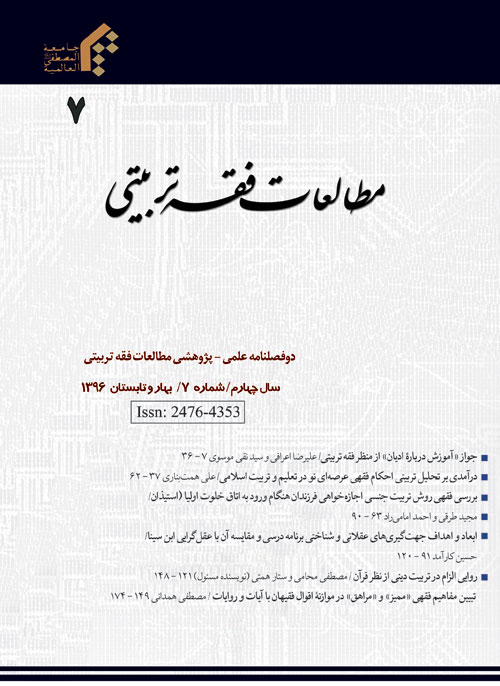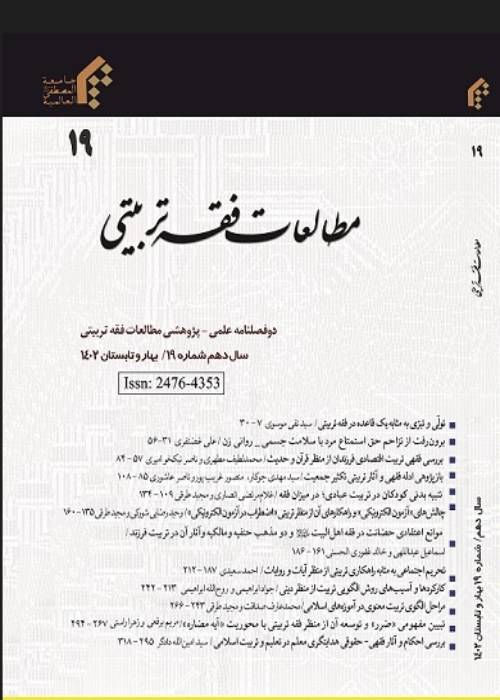فهرست مطالب

مجله مطالعات فقه تربیتی
سال چهارم شماره 7 (بهار و تابستان 1396)
- بهای روی جلد: 30,000ريال
- تاریخ انتشار: 1396/06/28
- تعداد عناوین: 6
-
-
صفحات 7-36
-
صفحات 121-148
-
Pages 7-36There has been an ongoing debate for the past several decades as to whether or not it is advisable to teach about religions rather than the "religion". The present study aims to examine this idea from the perspective of educational jurisprudence. The article examines all the arguments concerning permissibility of instruction involving religions. On this basis, eight arguments have been presented in defense of this very thought and it has been concluded that "teaching other religions" to a Muslim trainee is recommended and at times it would be obligatory, provided that it takes place only after he gets the necessary "Islamic training" or Islamic education.Keywords: religious education, religious education, religious education, educational jurisprudence, secular education, Islamic education
-
Pages 37-62The educational analysis of Islamic topics is among the important subjects pertaining to Islamic training and education (talim wa tarbiyat). It is a subject that needs to be studied from the perspective of both jurisprudence and education. The present article entitled "An Introduction to Educational Analysis of Current Legal Issues in Islamic Education" deals with the educational analysis of jurisprudential rules through a descriptive and analytical method. Based on the conclusions, analyzing jurisprudential rules is an inter-disciplinary task that deals with secrets, rationale, concepts, consequences and educational impacts of legal rulings, albeit with reliance on the most authentic Islamic sources such as the Quran, tradition, reason and experience. It is a subject that is somehow connected to certain topics such as "Interaction of jurisprudence and education", "educational jurisprudence" and "jurisprudential education". In terms of domain, educational analysis of Islamic rulings includes both educational themes and rules pertaining to general areas because fiqh (jurisprudence) is a branch of knowledge which, if used appropriately, can yield a lot of benefits in various educational spheres. In order to analyze jurisprudential rules from an educational perspective, there is a need for tools and sources among which, inter alia, is the Quran and prophetic traditions as well as the human intellect. Moreover, empirical data and scientific results of psychological and educational analyses can be used in this area.Keywords: Jurisprudential education, educational jurisprudence, jurisprudential ruling, secrets of jurisprudential rulings, educational effects, consequences of jurisprudential rulings, educational analysis of jurisprudential rulings
-
Pages 63-90Among the special methods of sexual education of children is the method involving children and related individuals seeking permission before entering their parent's or guardian's private room. In Islamic terminology, this is referred to as 'istizan' which is to seek permission. According to this method, the children are required to seek their guardian's permission before they enter their (guardians') bedroom and they cannot enter it unless allowed by them. This is a preventive method aimed at protecting the child against sexual disorder, perversion and anomaly as affirmed by the Holy Quran and some tradition. On this basis, it is specially recommended that a non-adult and immature child seek permission of his or her parents when he or she is willing to enter their bedroom. Meanwhile, in this study nine other subsidiary issues connected to this issue are discussed along with this same subject. The obligation of immature children, duty of parents, the scope and limit of their duty, the role of gender or sex of children are among those subsidiary issues discussed in this article. The importance of the three times mentioned in the Quranic verse as well as the timing of entering their rooms are yet among other issues dealt with in this study.Keywords: educational jurisprudence, child upbringing, sexual education, seeking permission, puberty
-
Pages 91-120This article seeks to study the various aspects and goals of rational and cognitive orientations of curricular programs comparing them with Avicenna's rationalism while using a descriptive and analytical method. Findings show that there are some commonalities between the rational and cognitive orientations of curricular programs and Avicenna's rationalism in terms of how both of them lay emphasis on intellectual growth and strengthening of the reasoning and thinking power of the learners. Nevertheless, such orientations especially the cognitive ones are incompatible with Avicenna's rationalism in the underlying layers and philosophical foundations that emanate more or less from empiricism. When it comes to the aspects and goals, there are some visible differences between them. The said orientations seek to help grow the trainees and strengthen their basic skills and ways of thinking whereas Avicenna propounds the issue of happiness and perfection relating them to his rationalism. According to Avicenna, the ultimate goal of rational empowerment and improving thinking capacity is to attain real perfection and ultimately cognition of the Lord. That is something achievable through the active intellect and by way of nurturing and growing the thinking power as well as knowledge of the realities of the universe and adherence to moral values.Keywords: Curricular program, Ibn Sina (Avicenna), Rational Orientation of Curricular program, Cognitive Orientation of Curricular program, Ibn Sina's rationalism
-
Pages 121-148In this study, "religious education" refers to all forms and areas of deliberate teaching, learning and educating processes for religion in a bid to enable trainees to learn the religion and have faith in its doctrines and adhere to its teachings in practice. On this basis, religious education is the central and most important component of Islamic tarbiyyah and education. It is so important that Islamic education without it will not be materialized and implemented in the real sense.
In a religious education, the instructor can benefit from various methods to educate people one of which is force or coercion. According to this method, trainees are forced to accept the religion, increase their conviction and faith and carry out religious instructions. Perhaps, it might appear in the beginning that the instructors do not have the right to compel other people to accept the religion and or perform practical obligations such as prayer but in reality religion is something that cannot be accepted through compulsion and coercion. Therefore, an important question arising here is whether or not the instructors are allowed to force and coerce the trainees in religious education.Keywords: coercion, compulsion, force, education, religious education -
Pages 149-174The terms "mumayyiz" (discerning child) and "murahiq" (a child who is close to puberty, but has not yet gone through it) are among the basic concepts in fiqh (jurisprudence) as they have been used extensively through this branch of knowledge. Although these two concepts have been used in various texts in different meanings, they are two jurisprudential terms that have been used extensively in the jurisprudence. So far an accurate and precise definition to clarify the components of these terms has not been presented. The definitions offered in some jurisprudential texts are limited and discrepant and their theoretical foundations are not clear. Sometimes, those definitions have these problems altogether. The present research aims to classify the applications of these concepts in fiqh (jurisprudence) explaining its definitions and various aspects as well as the theoretical foundations of each definition. Thus, it has implicitly reached this conclusion that a single and consistent definition of the term "mumayyiz" to encompass the entire jurisprudence would be incorrect. This term has been defined in different ways in accordance with the different chapters of 'ibadat (acts of worship) and muamelat (transactions). It has also presented a definition of "murahiq" which seems to have been used throughout fiqh. The author has also explained the relationship and difference between these two concepts.Keywords: child, discerning child, murahiq


